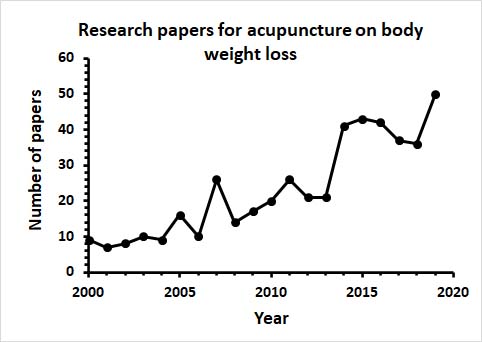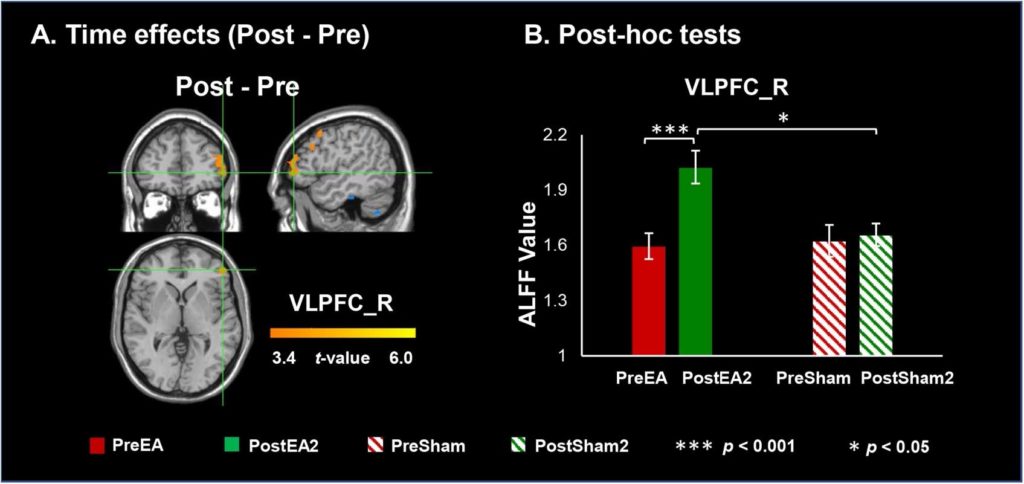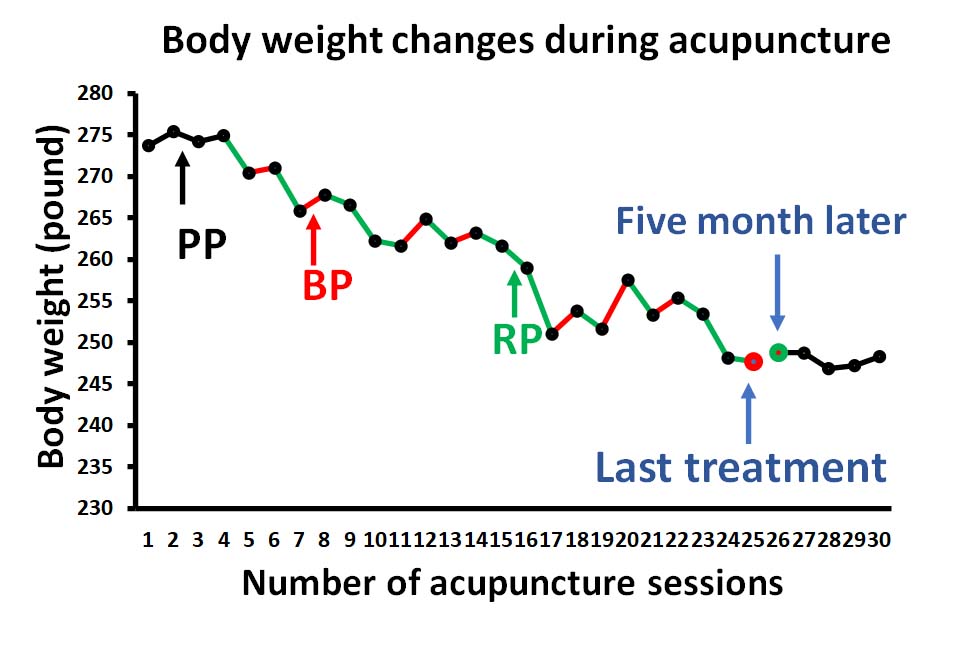Acupuncture For Weight Loss
1. Acupuncture is an effective treatment for reducing body weight
During recent two decades, researches on acupuncture for weight loss have been increased for 5.5 folds based on Pubmed. Most of those researches support acupuncture is an effective therapy for weight loss.
A review conducted by Zhong studied 8 clinic trials with 403 patients. They found that compared with sham acupuncture, acupuncture reduced body mass index, body weight, waist circumference, and body fat mass percentage, compared with controls. The review suggests that acupuncture is an effective therapy for simple obesity rather than a placebo effect.

Another review analyzed 12 clinic trials involved a total of 643 subjects including 338 participants received acupuncture and 305 participants received sham acupuncture. The review found that acupuncture is able to reduce body mass index in obese patients. The body fat mass significantly reduced in acupuncture group, compared with sham treatment. There were also significant reduced in waist circumference and hip circumference in the acupuncture compared with sham acupuncture groups.
47 clinic trials involved in 4861 subjects in acupuncture treatment groups and 3821 subjects in the control groups showed Acupuncture treatment duration from 2 weeks to 4 months, mean body weight reduced by 4.03 kg and a mean body mass index reduced by 1.32 kg m2 respectively, compared with placebo or lifestyle modification. Compared with the pharmacological treatments of sibutramine, fenfluramine or orlistat, acupuncture exhibited average body weight reduction 0.65 kg and average body mass index reduction 0.83 kg m2 respectively. Those studies showed that acupuncture was more effective than placebo or lifestyle modification in reducing body weight. Acupuncture had a similar efficacy as the Western anti-obesity drugs but with fewer reported adverse effects.
Mendon et al reviews the effect of auriculotherapy, which use acupuncture points in ear, on body weight and body mass index in overweight and patients with obesity. The review covers twelve studies, including four randomized controlled trials and five investigations. They found that auriculotherapy was effective in reducing weight and body mass index in overweight and patients with obesity.
2. Mechanisms of acupuncture for reducing body weight
It is not clear whether acupuncture needle directly burning calories in local point tissue plays an role in effect of acupuncture on reducing body weight or not , but research works have shown that acupuncture signal of weight loss is sent to brain through sensory receptor of peripheral never, and then brain through sympathetic never system to regulates weight reducing process.
1) Effect of sensory receptors of peripheral nerve in acupuncture signal of weigh loss
A study investigated whether peripheral nerve transfer acupuncture signal for lowering Cholesterol lever on rabbit animal model. The rabbits received acupuncture for 1-2 weeks after fed a high cholesterol diet for two or three weeks. They found cholesterol levels in both plasma and aortic were significantly decreased in acupuncture rabbits. When the acupuncture point was blocked by injection of a larger dose of novocain or by cutting the deep peroneal nerve, the effect of acupuncture on hypocholesterolemic was lost. Those results showed that stimulation of sensory receptors of the deep peroneal nerve at the acupuncture point is responsible for transduction acupuncture signal for lowing cholesterol level.
2. Effect of brain in the process of acupuncture for reducing body weight.
A research used resting state functional MRI (RS-fMRI) and amplitude follow frequency fluctuation (ALFF) to investigate acute/long-term effects of acupuncture on brain activity and resting state functional connectivity (RSFC) in overweight/obesity subjects, who received real/Sham acupuncture. For acute effects, 45 overweight/obesity subjects were divided into acupuncture groups and sham acupuncture groups respectively. There were significant time effects on ALFF in the right insula (INS) and left dorsolateral prefrontal cortex (DLPFC) due to decreases/increases in INS/DLPFC in both groups. There were weaker positive RSFC between INS and supplementary motor area (SMA)/right DLPFC and weaker negative RSFC between INS and precuneus (PCUN); stronger negative RSFC between DLPFC and dorsomedial-prefrontal-cortex (DMPFC) in both groups. There were weaker positive RSFC between INS and supplementary motor area (SMA)/right DLPFC and weaker negative RSFC between INS and precuneus (PCUN); stronger negative RSFC between DLPFC and dorsomedial-prefrontal-cortex (DMPFC) in both groups.
32 overweight/obesity subjects were involved in long term study. Results showed that body mass index (BMI) had significant reduction in acupuncture group compared with Sham groups. There were significant time effects on ALFF in right ventrolateral prefrontalcortex (VLPFC) due to significant increases in acupuncture group, and stronger positive RSFC between VLPFC and orbitofrontal cortex and negative RSFC between VLPFC and left thalamus (THA) in both groups after long-term treatment.
These findings suggest that changes in resting-activity and RSFC implicated in inhibitory-control, gastric-motility and satiety-control are associated with acupuncture-induced weight-loss.

3. Effect of sympathetic never on acupuncture for weight loss.
The sympathetic nerves system, which is known to play a role in thermogenesis and lipolysis by cross talk with other systems. A study by using high fat diet rat model found that acupuncture increases the activity of sympathetic nerves in inguinal white adipose tissue in rats, especially in the high fat diet rats. Acupuncture decrease sympathetic associated macrophage and the level of norepinephrine transporter protein (Slc6a2). The relative uncoupling protein 1 expression shows acupuncture increases thermogenesis, and increases b3 receptors. The results indicate that acupuncture exerts its anti-obesity effect via three mechanisms: (1) inhibition of sympathetic associated macrophage and the norepinephrine transporter protein SlC6a2, (2) promoting sympathetic associated macrophage activity and thermogenesis, and (3) regulating immunologic balance to promotive effect on lipolysis.

3. Body weigh changes during acupuncture treatments
Our clinic works have shown that acupuncture is an effective therapy in reducing weight for people with overweight or patients with obesity. In our weight lost treatment, specific diet and specific physical exercise do not require during acupuncture treatments although we encourage our patients to try their best. Our clinic data indicated that body weight loss by acupuncture, likes any other approaches, such as physical exercises and diet, is not a liner reducing process during treatment.
The changes of body weigh during acupuncture treatment have three phases. 1) Plateau phase (PP): Plateau phase usually occurs in first 3-4 acupuncture sessions. This phase is body initial responds to acupuncture stimulation. The body weight slightly changes either up or down around base line of body weight, but mean of body weight still remains same as before. 2) Reduce phase(RP): Body weight reduces by an average of 3-3.5 lbs per session. Reduce phase usually lasts 2 to 4 continuous sessions. 3) Gain phase(GP): In this phase, the patient can gain an average of 2-2.5 lbs of body weight. This phase usually only is one acupuncture session following reduce phase, and then immediately come back to the reduce phase. The cycle between reduce phase and gain phase continues during treatments.
The figure on right is one of my patient data that detail how body weight changes during acupuncture treatments. This patient was 57-year-old female with 273.7 lbs of initial body weight. After received twice per week for a total of 25 acupuncture sessions, her body weight was reduced to 247.7 lbs, which indicates that she lost a total of 26 lbs body weight in 25 acupuncture sessions. Her plateau phase (PP) was her first 4 sessions with 0.4+ 1.2 lbs body weight change. She had 14 acupuncture sessions in reduce phases (RP), which is 56% of total 25 sessions. She reduced a total of 45.2 lbs body weight during the 14 sessions, which indicated an average 3.22 lbs body weight reducing per sessions in reduce phase. She had 7 acupuncture sessions in gain phases (GP), account for 28% of total 25 sessions. She gained a total of 18 lbs body weight, which indicate an average 2.57 lbs body weight was gained per session in gain phase. 5 months later, she came back to my clinic. Her body weight still remained 248.8 lbs, which indicates effect of acupuncture on body weight control remains for 5 months period at least.

We believe at least part of the reason behind the gain phase is the body’s ability to activate adaptive mechanisms that act to minimize weight loss. Many researchers have found that weight loss is not a simple reduces fat tissue, but also triggers multiple body’s respond processes that defend baseline body weight. Those responds are involved in all of organs like heart, muscle mass, bone mass and hormone levels, et al. For example, body metabolic adaptation will increase signals for energy intake by up-related the hunger hormone such as ghrelin. Body metabolic adaptation also decrease in satiety hormones such as GLP-1, PYY, CCK, amylin. All of those responds attempt to bring body weight to its prior set point, which has been slowly developed over a number of years.
4. Visit Our Clinic
How many acupuncture sessions and frequency visits?
The number of acupuncture sessions depends on your weight loss goal. Our clinic’s results have shown that, on average, each acupuncture session can lead to a reduction of half a pound when conducted twice a week. For instance, if your weight loss goal is 10 pounds, you would require a total of 20 sessions.
Are there some restrictions during acupuncture period?
There are no specific restrictions. You can maintain your regular lifestyle and continue to eat what you like. However, we strongly encourage you to keep a record of your daily calorie intake and calorie expenditure. This data will not only guide you towards a healthier lifestyle but will also assist us in selecting the best acupuncture protocol for your treatment.
How to record daily calorie consume and expenditure?
1).Calorie Consume:
A simple way to calculate food calories is through a direct Google search. Just type “calories for [food name]” in the Google search bar.
Additionally, there are several free smartphone apps available for tracking and calculating food calories. Here are a few of examples:
A: MyFitnessPal: MyFitnessPal is a widely used app that allows you to track your food intake, log your meals, and calculate calories. It has a large database of foods and allows you to scan barcodes for quick input.
B: Lose It!: Lose It! is another popular app that helps you track your calories, macronutrients, and exercise. It also offers a barcode scanner for easy food entry.
C: Cronometer: Cronometer focuses not only on calories but also on detailed nutrient tracking. It provides information about vitamins, minerals, and other nutrients in your diet.
D:FatSecret: FatSecret offers a simple and user-friendly interface for tracking your food intake and calculating calories. It also has a barcode scanner and a food diary.
E: Yazio: Yazio offers personalized meal plans, a calorie tracker, and a food diary. It also has a feature that allows you to take pictures of your meals for easy tracking.
F: SparkPeople: SparkPeople offers a calorie counter and a food diary. It also includes a community aspect where you can connect with others on their health and fitness journey.
G: Lifesum: Lifesum provides personalized meal plans, calorie tracking, and recipes. It focuses on helping you make healthier food choices.
Keep in mind that accurate calorie tracking depends on the accuracy of the food information you input, so it’s important to use verified data when possible.
2).Calorie expenditure
Your daily calorie expenditure is sum of Basal Metabolic Rate (BMR) and your daily activity burn calories.
BMR: BMR is the total calories of your body needs to perform essential, life-sustaining functions at rest, which include circulation, breathing, cell production, nutrient processing, protein synthesis, and ion transport.
Harris-Benedict Equation is widely used method to to estimate BMR.
For Men: BMR = 88.362 + (13.397 × weight in kg) + (4.799 × height in cm) – (5.677 × age in years)
For Women: BMR = 447.593 + (9.247 × weight in kg) + (3.098 × height in cm) – (4.330 × age in years)
3). One example of Mr. John:
John is 65 years old man. His high is 178cm and his weight is 94kg.
His calorie consumes and spending at day XX/XX/XXXX
His daily calories spending at day 9/9/2022
His total balance of calorie consume is 1512-2360=-848. One gram fat produces 9 calories. If we assume the -858 calories burn body fat, his body weight reduced 848 /9= 94 gram.
His calorie consumes at XX/XX/XXXX
Foods | Calories | |
Breakfast | one cup of coffee with sugar and cream | 77 |
| one olive oil fried egg | 102 |
| one slice bread and butter | 165 |
Lunch | Two slice Pizza | 570 |
| one cup of coffee with sugar and cream | 77 |
Dinner | one Lettuce salad | 45 |
one apple | 95 | |
one-piece Bundi cake | 381 | |
Total |
| 1512 |
His daily calories spending at day XX/XX/XXXX
Calories | |
BMR | 1806 |
Daily activity | 564 |
Total | 2370 |
5.Reference
1. Rong-Qiang Zhang, Jiao Tan , Feng-Ying Li, Yong-Hong Ma, Li-Xin Han, Xiao-Li Yang , Acupuncture for the Treatment of Obesity in Adults: A Systematic Review and Meta-Analysis Postgrad Med J 2017 Dec;93(1106):743-751.PubMed
2.Yu-Mei Zhong , De-Li Lai, Yang Chen, Xiao-Chao Luo, Wen-Ting Lu, Ya-Nan Shang , Lin-Lin Zhang , Hai-Yan Zhou, Acupuncture vs Sham Acupuncture for Simple Obesity: A Protocol for Systematic Review and Meta-Analysis. Medicine (Baltimore) 2019 Oct;98(42):e17562. PubMed
3.Y Sui, H L Zhao, V C W Wong, N Brown, X L Li, A K L Kwan, H L W Hui, E T C Ziea, J C N Chan, A Systematic Review on Use of Chinese Medicine and Acupuncture for Treatment of Obesity, Obes Rev. 2012 May;13(5):409-30.PubMed
4.Carolina Rodrigues Mendonça, Larissa Silva Coelho Dos Santos , Matias Noll , Erika Aparecida Silveira , Jalsi Tacon Arruda, Effects of Auriculotherapy on Weight and Body Mass Index Reduction in Patients With Overweight or Obesity: Systematic Review and Meta-Analysis, Complement Ther Clin Pract 2020 Feb;38:101069.PubMed
5.Yuanyuan Ren, Mingzhu Xu, Karen M von Deneen, Yang He, Guanya Li, Yang Zheng, Wenjing Zhang, Xiaoping Li, Yu Han, Guangbin Cui, Gang Ji, Yongzhan Nie, Yi Zhang. Acute and Long-Term Effects of Electroacupuncture Alter Frontal and Insular Cortex Activity and Functional Connectivity During Resting State, Psychiatry Res Neuroimaging 2020 Apr 30;298:111047.PubMed
6.C C Wu, C J Hsu, Neurogenic Regulation of Lipid Metabolism in the Rabbit. A Mechanism for the Cholesterol-Lowering Effect of Acupuncture, Atherosclerosis 1979 Jun;33(2):153-64.PubMed
7.Mengjiang Lu, Yan He, Meirong Gong, Qian Li, Qianqian Tang, Xuan Wang, Yaling Wang, Mengqian Yuan , Zhi Yu, Bin Xu, Role of Neuro-Immune Cross-Talk in the Anti-obesity Effect of Electro-Acupuncture, Front Neurosci, 2020 Feb 28;14:151.PubMed
8.F L Greenway, Physiological Adaptations to Weight Loss and Factors Favouring Weight Regain, Int J Obes (Lond), 2015, Aug;39(8):1188-96.PubMed
